Power Consumption
Idle power consumption on 120V power we saw around 12-14W idle. We generally assume these nodes will use 9-12W idle so this seems to be a bit higher than we normally expect but it is a few watts, not an enormous gap. Again, we do see power consumption creep slightly higher over time if dust accumulates in the fan/ heatsink and we had a new unit here. Still directionally this is where we would expect.
The power supply for this unit is a 90W HP power adapter from the company’s notebook line. As you would expect, you can use the adapters from the company’s notebooks with this machine. We did get into this 89-91W range during our benchmarking so we would have liked to have seen a larger power supply. With USB charging ports it feels like this needs to be a higher capacity unit. Again, a larger power supply also starts to mitigate some of the benefits of moving to a smaller form factor.
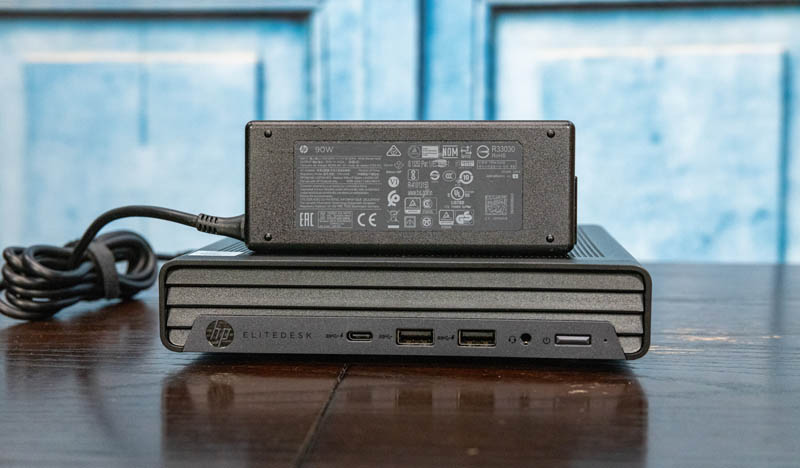
At idle, the system is not silent, but it is very quiet if working from 1M away. Below 40-60% load the noise was acceptable but running at 100% load for extended periods of time will ramp fans. We will quickly note that the 65W TDP EliteDesk 800 G6 units with GPUs and one should expect more fan noise with those higher-power options. We also would expect a GPU-equipped unit to come with a larger power supply.
Key Lesson Learned for TMM
In this series, we wanted to also focus on some key lessons learned. Since we have already tested well over a dozen different models, we are taking away key pieces of advice from each that we wanted to share.
The key lesson learned here is clearly around the 35W v. 65W version. Having both, and having used both for some time, the question is simply: Is it worth getting the 65W version?
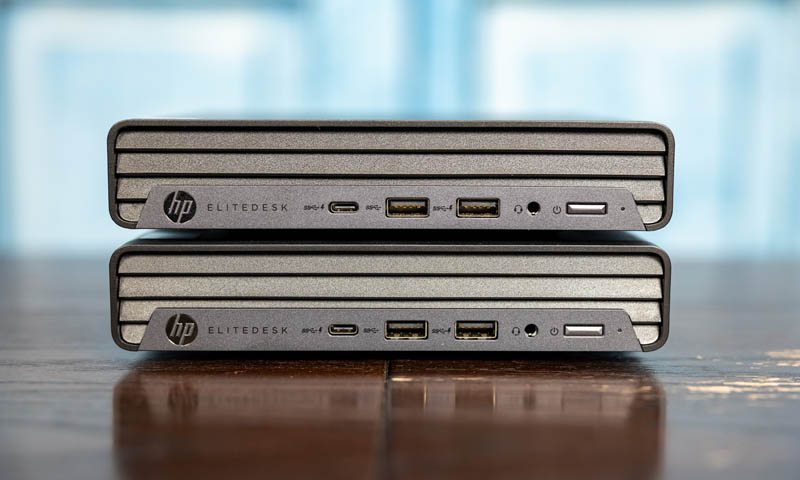
The allure of the 65W version is additional performance. Having a system that can hit higher turbo clocks also means that it can hit performance levels more akin to a modern desktop PC, yet in a 1L form factor. That is not something lost in terms of its appeal. Realistically, the Core i5-10500(T) is great because it brings 6 cores/ 12 threads to this segment that only a few generations earlier was annually refreshing parts at the 4 core/ 4 thread level. This is a massive generational jump. As a result, the Core i5-10500T probably feels more like a Core i7 of a generation prior and the Core i5-10500 feels maybe 1-2 steps above that.
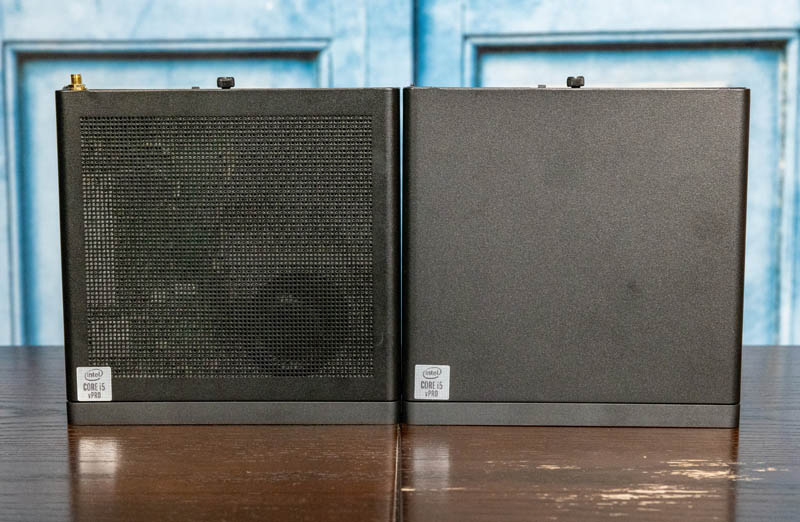
Still, there are trade-offs. For that additional performance, one gets higher power consumption. There is a perforated top that limits the ability to stack these units as clearly thermals are a challenge in the 65W version. When the fan ramps, it is very noticeable. HP’s design does not just put the perforated top above the fan inlet, instead, it is almost the entirety of the chassis meaning this is not one I would look forward to from a dust perspective. As these units age, they tend to accumulate dust anyway, and as a result, fans spin up to higher speeds.
We also spent quite a bit more on this unit. Although we also got 8GB more of memory, we still had a ~$150 premium without the memory.
Personally, I do not think this changes my opinion of recommending 35W over 65W units for TinyMiniMicro. I thought perhaps it was substantially different in this generation, but it appears as though it is not.
Final Words
Overall, HP has a very nice package with the HP EliteDesk 800 G6 Mini. Now that we have tested both the 65W and the 35W versions, we have an appreciation for the platform.
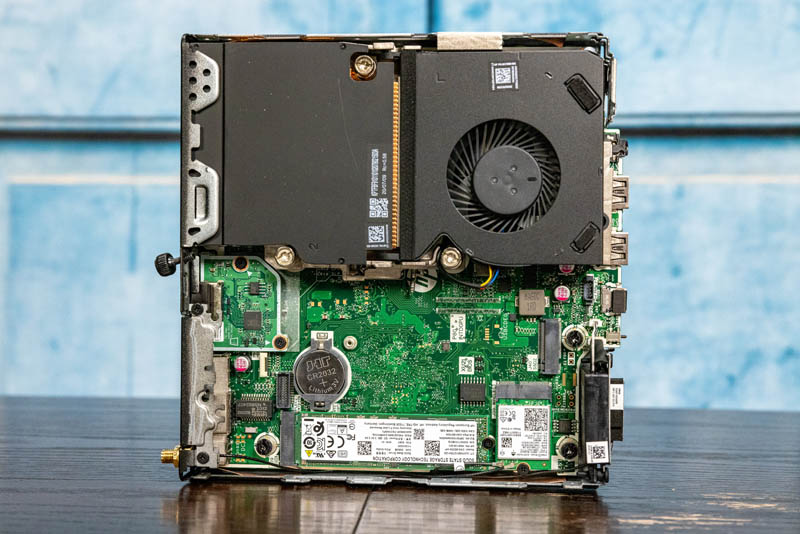
This generation offers a lot of value with the newer Core i5-10500 offering a 6 core / 12 thread solution in just 1L. That includes clock speeds of up to 4.5GHz on this CPU and up to 4.8GHz on the i5-10600. Looking back to the 6th and 7th generation core-based systems only a few generations prior, this is absolutely massive in terms of performance gains and just compute capacity in these 1L PCs.

Again, HP needs to fix its poor USB port speed labeling as Dell and Lenovo are leading in that. It may seem like a minor nit, but picking up and finishing this review a few months later, I needed to look up the port configuration.
Overall, HP has a great hardware platform. I shared a bit of my personal perspective on this, but I do also realize that there are many who will simply prefer getting the faster HP EliteDesk 800 G6 Mini 65W TDP CPU version. Still, it was great getting to take another look at the 35W v. 65W options that this segment offers.

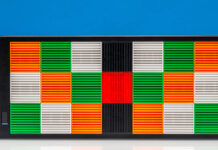

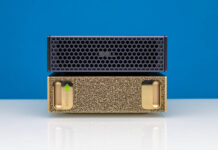
Is there a compact way of powering multiple TMM PCs? The power bricks and cabling always turn into a mess. Do you know of a decent single supply for multiple units? I’ve found some solutions via search (particularly for bitcoin farms) but they’re all rather janky!
Y0s there is another challenge doing this. The TMM units usually detect a genuine PSU and its output so just a simple DC PSU that is split will not work.
I have not found a great solution yet.
in my experience it’s a simple voltage check, the centre pin needs to be the correct voltage. HP user this to determine its capability with regards to wattage etc.
I personally have hacked two cables onto one 135W HP power supply to supply two HP 35W TDP G3’s. Been working fine.
Patrick, Glad to hear that y’all made it to Austin, TX and the Blue Door Screen did, too.
I’d love it if we could get TMM style machines that snapped onto DIN rails. They would be the ultimate home servers.
Hi.
Compared to a Mac mini late 2019 which will shut off fans most of the time while doing light tasks like office documents or web browsing. How much do the fans on the HPs spin up? Do they run all the time or can they completely shut off like in the mac mini?
Hello. I have a G5 model with an i7 and I like it alot for my home automation stuff.
I do wonder about the heat inside and notice that the 65 watt unit you show has a ventilated cover while the 35 watt unit does not. My unit does not have this cover. So:
(a) should I consider getting a different cover?
(b) are the covers interchangable between generations of the 800 mini?
Thanks
I’m researching information on those and they say in the documentation that you can’t use the Nvidia Flex IO with 65w cpu
AvailableGraphics
Integrated: Intel®UHDGraphics 610; Intel®UHDGraphics 630
Discrete: NVIDIA®GeForce®GTX 1660 Ti(6 GB GDDR6 dedicated)*
*Only Available on 35W processor.
https://h20195.www2.hp.com/v2/GetPDF.aspx/c08338984.pdf